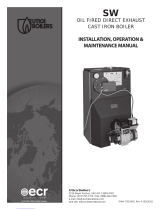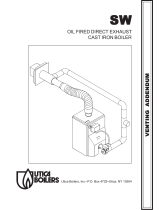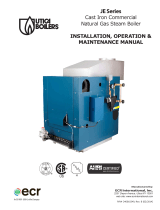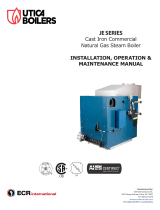
7
4.
When air for combustion and room ventilation is from
inside buildings, conned space shall be provided with
two permanent openings, one starting 12 inches from
the top and one 12 inches from the bottom of the
enclosed space. Each opening shall have a minimum
free area of 1 square inch per one thousand (1,000)
Btu per hour of the total input rating of all appliances
in the enclosed space, but must not be less than one
hundred (100) square inches. These openings must
freely communicate with the interior areas having
adequate inltration from the outside. See Figure #1.
5.
When the boiler is installed in a conned space and
all air is provided from the outdoors, the conned
space shall be provided with two permanent openings,
one commencing within 12 inches from the top and
one commencing 12 inches from the bottom of the
enclosure. The openings shall communicate directly, or
by ducts, with the outdoors or spaces (crawl or attic)
that freely communicate with the outdoors. One of the
following methods must be used to provide adequate
air for ventilation and combustion.
A. When directly communicating with the outdoors,
each opening shall have a minimum free area
of 1 square inch per 4,000 Btu per hour of total
input rating of all equipment in the enclosure. See
Figure #2.
VENTILATION & COMBUSTION AIR
B. When communicating with the outdoors by means
of vertical ducts, each opening shall have a
minimum free area 1 square inch per 4,000 Btu per
hour of total input rating of all appliances in the
enclosed space. See Figure #3.
C. If horizontal ducts are used, each opening shall
have a minimum free area 1 square inch per 2,000
Btu per hour total input rating of all appliances in
the enclosed space. See Figure #4.
D. When ducts are used, they shall be of the same
cross sectional area as the free area of the area of
the openings to which they connect. The minimum
dimension of rectangular air ducts shall not be less
than 3 inches.
6.
In calculating free area using louvers, grills or screens
for the above, consideration shall be given to their
blocking effect. Screens used shall not be smaller than
¼ inch mesh. If the free area through a design of
louver or grill is known, it should be used in calculating
the size opening required to provide the free area
specied. If the design and free area is not known,
it may be assumed that wood louvers will have 20-
25% free area and metal louvers and grills will have
60-75% free area. Louvers and grills shall be xed in
the open position or interlocked with the boiler so that
they are opened automatically during boiler operation.
Refer to the Combustion Air Requirements chart on
previous page for combustion air minimum opening
requirements.
Figure #1


























